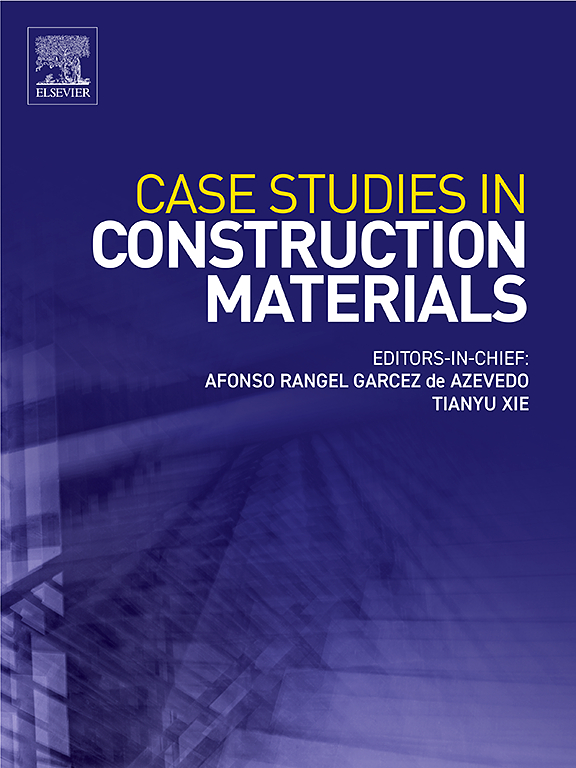Engineering properties and life cycle assessment of a rapidly clayey soil stabilizer utilizing alkali-activated GFRP waste powder and slag
IF 6.5
2区 工程技术
Q1 CONSTRUCTION & BUILDING TECHNOLOGY
引用次数: 0
Abstract
The increasing production of waste glass fiber reinforced polymer (GFRP) is causing severe environmental pollution, highlighting the need for an effective treatment method. This study explores recycling waste GFRP powder to substitute ground granulated blast furnace slag (GGBS) in synthesizing geopolymers, aiming to rapidly stabilize clayey soil. The impact of GFRP powder replacement, alkali solution concentration, alkaline activator/precursor (A/P) ratio, and binder content on the geomechanical properties and permeability of stabilized soil was thoroughly examined. The findings revealed that replacing GFRP powder from 20 wt% to 40 wt% lowered the unconfined compressive strength (UCS). However, soil stabilized with 30 wt% GFRP powder displayed the highest shear strength. This indicates that the incorporation of an appropriate amount of GFRP powder elevates clay cohesion. Furthermore, an increase in GFRP powder replacement improved permeability coefficient in the early stages, with minimal impact observed after 28 days. Scanning electron microscopy with energy dispersive spectroscopy (SEM-EDS) analysis revealed a microstructural evolution of the stabilized soil, transitioning from a porous to a denser, more homogeneous composition over the curing period, which can be attributed to the formation of cluster gels enveloping the soil particles. Life cycle assessment (LCA) analysis indicated that the GFRP powder/GGBS geopolymer presents an alternative option to traditional Ordinary Portland Cement (OPC) binder, featuring a global warming potential (GWP)/strength ratio reduction of 6 %-40 %. This research offers a practical solution for effectively utilizing GFRP waste in a sustainable manner, with minimal energy consumption and pollution, thereby contributing to the sustainable development of soil stabilization.
碱活化GFRP废粉渣快速黏性土稳定剂的工程性能及生命周期评价
废旧玻璃纤维增强聚合物(GFRP)的产量不断增加,造成了严重的环境污染,迫切需要一种有效的处理方法。本研究探索利用废旧GFRP粉替代磨粒高炉渣(GGBS)合成地聚合物,以快速稳定粘性土。研究了GFRP粉替代量、碱溶液浓度、碱性活化剂/前驱体(A/P)比、粘结剂含量对稳定土地质力学性能和渗透性的影响。结果表明,将GFRP粉从20 wt%替换为40 wt%可降低无侧限抗压强度(UCS)。而30% wt% GFRP粉稳定土的抗剪强度最高。说明掺加适量GFRP粉提高了粘土黏聚力。此外,GFRP粉替代量的增加在早期阶段改善了渗透系数,28天后观察到的影响最小。扫描电子显微镜和能量色散能谱(SEM-EDS)分析显示,在固化过程中,稳定土的微观结构发生了演变,从多孔向致密、均匀的成分转变,这可归因于包裹土壤颗粒的团簇凝胶的形成。生命周期评估(LCA)分析表明,GFRP粉/GGBS地聚合物是传统普通硅酸盐水泥(OPC)粘结剂的替代选择,其全球变暖潜能值(GWP)/强度比降低6 %-40 %。本研究为可持续有效利用GFRP废弃物提供了一种可行的解决方案,使其能耗和污染最小化,从而促进土壤稳定的可持续发展。
本文章由计算机程序翻译,如有差异,请以英文原文为准。
求助全文
约1分钟内获得全文
求助全文
来源期刊

Case Studies in Construction Materials
Multiple-
CiteScore
7.60
自引率
19.40%
发文量
842
审稿时长
63 days
期刊介绍:
Case Studies in Construction Materials provides a forum for the rapid publication of short, structured Case Studies on construction materials. In addition, the journal also publishes related Short Communications, Full length research article and Comprehensive review papers (by invitation).
The journal will provide an essential compendium of case studies for practicing engineers, designers, researchers and other practitioners who are interested in all aspects construction materials. The journal will publish new and novel case studies, but will also provide a forum for the publication of high quality descriptions of classic construction material problems and solutions.
 求助内容:
求助内容: 应助结果提醒方式:
应助结果提醒方式:


